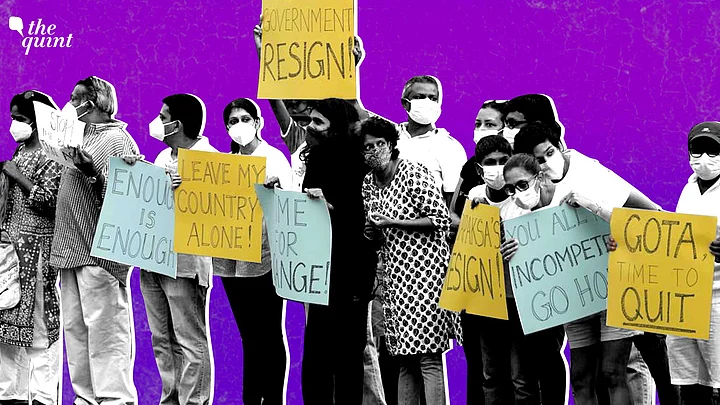Public anger is on the rise in Sri Lanka as the country’s worst economic crisis in 70 years plunges its citizens into a dire situation.
With rolling power outages and a continued scarcity of essential items, civil unrest is growing with a resounding cry of "Go Home Gota" and "Gota Go Back", as people demand the all-powerful Rajapaksa family, which has held key positions in the government, to step down.
As angry protesters poured into streets in defiance of the 36-hour-long curfew on Sunday, 3 April, in what is being dubbed as the country's "Arab Spring" moment, all 26 members of the Sri Lankan Cabinet resigned en masse, save for Mahinda Rajapaksa, who will continue to be the prime minister and his brother Gotabaya, who is the president.
But now the question is – what next for Sri Lanka?
Cabinet Resignations – Too Little, Too Late?
Far from improving matters, the attempt of a Cabinet reconfiguration only escalated the crisis in the government further.
On 4 April, four people – Dinesh Gunawardena, Johnston, Fernando, and GL Peiris and Ali Sabry – all of whom have been a part of the older Cabinet, were inducted into the new Cabinet.
But just a day after President Gotabaya Rajapaksa replaced his brother Basil with Ali Sabry, the new finance minister quit his post on Tuesday.
In a letter, Ali Sabry stated that after much deliberation he was of the view that the president should make "suitable interim arrangement to navigate this unprecedented crisis, fresh and proactive and unconventional steps need to be taken, including the appointment of a new Finance Minister."
Expectedly, common citizens and the Opposition are far from being placated, with local media reporting gatherings of protesters outside the residences of almost all government MPs asking them to resign immediately.
Opposition MP Udaya Gammanpila called the new Cabinet "old wine in a new bottle", while Sajith Premadasa, Leader of Opposition, called it all a "melodrama to dupe people".
"We want resignations and then we want a political model that works", he tweeted.
Can There Be a Change of Leadership?
As Sri Lanka faces 17 percent inflation rate owing to critical shortfall of foreign currency, the sentiment on ground is that of seeking a change.
But can there be a change in leadership at this given moment?
Even as the president appeared to be in damage control mode, inviting members of the Opposition to accept portfolios in the new Cabinet, the Rajapaksa family's grip over the government seemed to be weakening, with the ruling coalition losing majority on 5 April, as 41 legislators exited the alliance.
Among them were 14 MPs from the government's main coalition partner, the Sri Lankan Freedom Party (SLFP).
As the ruling SLPP tries to hold on to its 113 seats so that it can continue to be in power with a simple majority, M Sathiya Moorthy, head of the Observer Research Foundation’s (ORF's) Chennai Initiative, points out that bringing in new leadership will still be easier said than done.
"The main Opposition doesn’t have more than 54 MPs. They will need more than double that number to form the government in the 225-member Parliament. And, that is going to be a difficult task, as things stand currently. In any case if that was so easily done, then the Opposition would have attempted it already."M Sathiya Moorthy, Head of Observer Research Foundation’s Chennai Initiative
"The alternative is to hold fresh elections and that can happen either just six months before the conclusion of the term of the present Parliament. Or, the Parliament has to pass the resolution for new elections," he added.
Recently, in an interview to Times of India, former Prime Minister Ranil Wickremesinghe, who is one of the veteran leaders in the Opposition, also raised doubts about the possibility of fresh elections.
“Electioneering will take four to five months. Meanwhile, the Sri Lankan Rupee may further depreciate down to 500, perhaps even 1,000 to a dollar. We can’t afford that,” he had said.
How Likely is a Constitutional Crisis?
There are also concerns around whether the economic crisis can also eventually lead to a constitutional crisis.
The last time that country faced a constitutional crisis was in 2018, when then President Maithripala Sirisena appointed Mahinda Rajapaksa as Prime Minister before formally dismissing the incumbent PM Ranil Wickremesinghe, resulting in two concurrent prime ministers.
But ORF's Moorthy said the country may not have to face the worst case scenario.
"A constitutional crisis is not likely unless the Supreme Court or the Parliament can’t intervene. Secondly, although the Opposition supported Sunday's protest, there were views within the party that they should not let things go beyond a particular point where things go out of control."M Sathiya Moorthy, Head of Observer Research Foundation’s Chennai Initiative
"It can take such a shape if the economic crisis continues but from what we’ve been reading, India’s assistance in fuel, medicines etc, will pour in from this week, so there is going to be a moderate improvement of situations. Yet, how long will that be sustainable, that’s certainly a question," he said.
